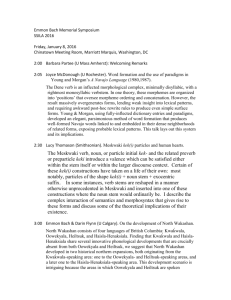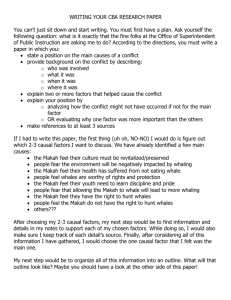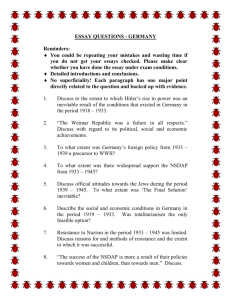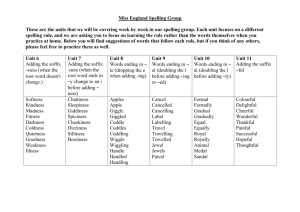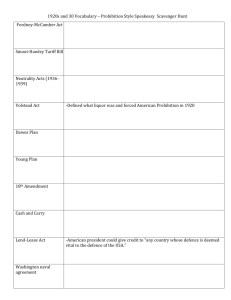Mithun Stanford
advertisement
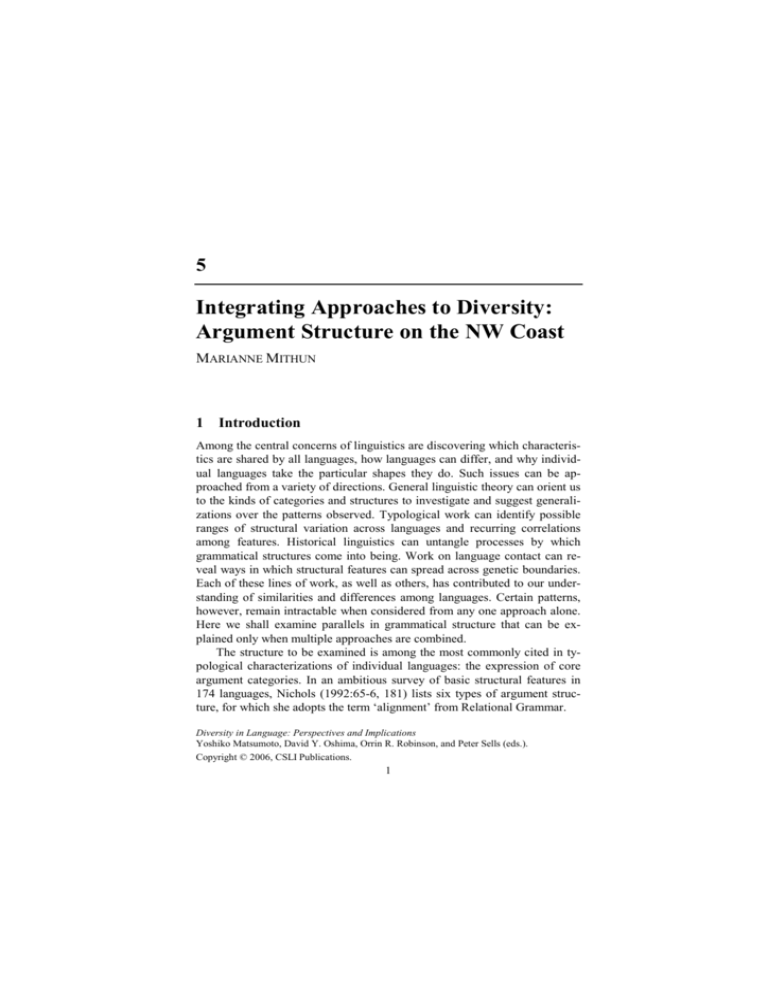
5 Integrating Approaches to Diversity: Argument Structure on the NW Coast MARIANNE MITHUN 1 Introduction Among the central concerns of linguistics are discovering which characteristics are shared by all languages, how languages can differ, and why individual languages take the particular shapes they do. Such issues can be approached from a variety of directions. General linguistic theory can orient us to the kinds of categories and structures to investigate and suggest generalizations over the patterns observed. Typological work can identify possible ranges of structural variation across languages and recurring correlations among features. Historical linguistics can untangle processes by which grammatical structures come into being. Work on language contact can reveal ways in which structural features can spread across genetic boundaries. Each of these lines of work, as well as others, has contributed to our understanding of similarities and differences among languages. Certain patterns, however, remain intractable when considered from any one approach alone. Here we shall examine parallels in grammatical structure that can be explained only when multiple approaches are combined. The structure to be examined is among the most commonly cited in typological characterizations of individual languages: the expression of core argument categories. In an ambitious survey of basic structural features in 174 languages, Nichols (1992:65-6, 181) lists six types of argument structure, for which she adopts the term ‘alignment’ from Relational Grammar. Diversity in Language: Perspectives and Implications Yoshiko Matsumoto, David Y. Oshima, Orrin R. Robinson, and Peter Sells (eds.). Copyright © 2006, CSLI Publications. 1 2 / MARIANNE MITHUN a) b) c) d) e) f) Neutral (in which there are no inflectional oppositions) Accusative Ergative Three-way Stative-Active (in which she includes Agent-Patient systems) Hierarchical Focusing on morphology, Nichols concludes (1992:181) that these patterns show high genetic stability and resistance to borrowing. An intriguing pattern of argument marking occurs in some languages indigenous to the Northwest Coast of North America. The Northwest Coast is a well-known linguistic area, comprising a number of distinct, genetically unrelated language families (Thompson and Kinkade 1990). The area is shaded in Figure 1. Figure 1. The Northwest Coast linguistic area (Adapted from Suttles 1990:iii) Some languages in the center of the area, members of the Wakashan, Chimakuan, and Salishan families, show a particularly unusual pattern of identifying core arguments. Viewed from a cross-linguistic perspective, these languages provide excellent examples of diversity: the patterns they exhibit are unlike those of the majority of the world’s languages. Yet compared with each other, they show surprising similarity: their systems are strikingly parallel in abstract structure, though not in substance. Both the diversity and the similarity cry out for explanation. Why should such a structure exist, and why should it be shared? The similarity cannot be a common inheritance, for INTEGRATING APPROACHES TO DIVERSITY / 3 the languages are not genetically related; it is unlikely to be the result of chance, because the structure is so rare; if Nichols is correct, it should also not be attributable to language contact, because this domain of the grammar is assumed to be highly resistant to borrowing. The three language families can be seen in Figure 2, which shows the center of the Northwest Coast area. Figure 2. The Wakashan, Chimakuan, and Salishan families (Adapted from Suttles 1990:ix) 4 / MARIANNE MITHUN The Wakashan family in the west consists of two branches, North Wakashan and South Wakashan. North Wakashan contains three languages: Haisla, Oowekyala/Heiltsuk (Haihais, Bella Bella), and Kwak’wala (Kwakiutl). South Wakashan also contains three languages: Nootka (Nuuchahnulth), Nitinaht (Ditidaht), and Makah. The Chimakuan family in the south contains just two languages: Quileute and Chemakum. The Salishan family stretches eastward, with twenty-three languages in all. Those visible in Figure 2 are Bella Coola (Nuxalk), the Northern Coast languages, and the Central Coast languages. 2 The Structures In languages of the Wakashan family, core arguments are identified only by pronominal enclitics attached to the initial predicate. Lexical nominals carry no case marking and constituent order does not distinguish grammatical role. Examples of the pronominal pattern can be seen below in Nuuchahnulth (Nootka). First person singular is =s, and second person singular is =k. Third persons are unmarked. (1) Nuuchahnulth (Wakashan) pronominals: Nakayama 1997a, 2003a waþšiýaÿ=s wikýaqÿ=s suutiþ wiiqĜap naýaa=s ýuuyimþckwi=s ĝiiĜšiÿ=s ýiič’imýaÿ=s waþsaap’at=s n’aacsaat=s qwayac’iikýi wa:þšiÿwaýic=k wičšaĜapýic=k naýuuqsýaqÿýic=k siičiþ huĜtakšiÿýaqÿic=k kwistuupsuu=k c’iišĜiiýic=k qwisýanitii=k ýayaýaqÿ’atýic=k ýaýataþýat ‘I went home’ 2003:195 ‘I will not harm you’ 2003:383 ‘I understood’ 2003:169 ‘I was born’ 2003:163 ‘I cried’ 2003:166 ‘I am old’ 2003:451 ‘They sent me home’ 2003:167 ‘The wolf was watching me’ 2003:383 ‘They say you are going home’1997a:33 ‘You are doing it the wrong way’ 1997a:32 ‘You will come along with me’ 2003:510 ‘You will know’ 2003:640 ‘You are extraordinary’ 2003:489 ‘You are dirt!’ 2003:624 ‘whatever they did to you’ 2003:371 ‘Many will ask you questions’ 2003:503 The same Nuuchahnulth forms correspond to English subjects (‘I went home’) and English objects (‘They sent me home’), so the system does not appear to be nominative/accusative. The same forms are used in transitive and intransitive clauses (‘I will not harm you’, ‘I cried’), so it is not erga- INTEGRATING APPROACHES TO DIVERSITY / 5 tive/absolutive. The same forms are used for semantic agents and patients (‘I went home’, ‘I was born’), so it is not agent/patient. The same forms are used in events and states (‘I went home’, ‘I am old’), so it is not active/stative. A similar pronominal pattern can be seen in the Chimakuan family to the south. The sentences in (2) are from the Quileute language. Here, too, the system does not appear to distinguish subjects and objects: the same second person singular pronominal enclitic =litš is used in ‘you bought it from me’, ‘he will skin you’, and ‘it was killed for you’. The system is not ergative/absolutive: the same clitic is used in the intransitive ‘you left’ and the transitive ‘you hit us’. The system is not agent/patient: the same form is used for the semantic agent in ‘you are placing it wrong’ and the semantic patient in ‘you were hurt’. It is not active/stative: the same form is used in the action ‘you will come along’ and the state ‘you will know’. (2) Quileute (Chimakuan) pronominals: Andrade 1931, 1933 táaþeweÛtsiÛ=litš xwá’t’sátilo=litš xwá’t’sásto=litš tiþatlista=litš luwáqawéþas=itš téÛwa’áþku=litš q’isitsil=litš kulesel=í’ilitš ba’k’eta’yu=litš sayá’aqa=litš xalitsil=í’ilitš t’ata’aqa=litš ada’adaþsel=elitš t’šiqaselé=litš t’axt’šeÛþitsel=ilitš t’lá’q’ast’ádaßátsel=ilitš ‘you left’ ‘you hit us’ ‘you were hitting us’ ‘you bought it from me’ ‘you are placing it wrong’ ‘you are invited’ ‘you were hurt’ ‘you will be named’ ‘you had been asked’ ‘he likes you’ ‘he will skin you’ ‘he knows you, they know you’ ‘he spoke to you’ ‘it was killed for you’ ‘they warmed your feet’ ‘he slapped you with his tail’ 1931:36.12 1933:236 1933:236 1933:239 1931:48.48 1931:38.9 1933:245 1933:245 1933:245 1933:244 1933:244 1933:244 1933:244 1933:245 1933:245 1933:245 A pronominal pattern similar to those in Nuuchahnulth and Quileute can also be seen in a third family, the Salishan family to the east. 6 / MARIANNE MITHUN (3) Sooke (Salishan) pronominals: Efrat 1969 iéý=sn k’wtíx w=sn ýáß wtx w=sn mĉ kwªþnáüª=sn čítü=sn mĉkwªþnüq=sn þĉmýx wtüý=sn ß wªýátüč’tªý=sn ‘I’m going’ ‘I can see it’ ‘I’m bringing it there’ ‘I hurt you’ ‘I slipped down’ ‘I might get hurt accidentally’ ‘it’s raining on me’ ‘they must be crying for me’ 1969:99 1969:95 1969:95 1969:94 1969:99 1969:101 1969:101 1969:185 The first person singular pronominal clitic is =sn whether it represents the agent of a transitive or intransitive, the patient of a transitive or intransitive, or a beneficiary, and whether the clause portrays an event or state. The three languages show remarkable parallelism in their pronominal marking. All three show hierarchical structure. In most transitive clauses, only one participant is represented pronominally. The choice of which participant to represent does not depend on grammatical role, but on person. The systems in the different languages are not identical, however. 3 The Wakashan Family Though the parallels among the hierarchical systems in the three families are striking, the systems are not perfectly equivalent even within families. 3.1 South Wakashan: Nuuchahnulth Nuuchahnulth, also called Nootka, consists of a number of dialects spoken primarily along the western side of Vancouver Island in British Columbia. (The term ‘Nuuchahnulth’ is used in some contexts to include speakers of two languages, Nootka and Nitinaht. It is used here for just the Nootkan dialects, which are considered mutually unintelligible with Nitinaht.) In Nuuchahnulth, only one participant is usually identified by a pronominal clitic in a clause, whether coreferential lexical nominals are also present or not. Two principles determine which argument is chosen. a) First and second persons have priority over third: 1, 2 > 3 b) If only first and second persons are involved, the semantic agent has priority over the patient: A>P If a first or second person acts on a third (1/3, 2/3), just the agent is represented: ‘I sent (him)’, ‘You sent (him)’. If a third person acts on a first or second (3/1, 3/2), just the patient is represented: ‘(He) sent me’, ‘(He) sent INTEGRATING APPROACHES TO DIVERSITY / 7 you’. If only first and second persons are involved (1/2, 2/1), it is the agent that is represented: ‘I sent (you)’, ‘You sent (me)’. Third persons are not represented overtly. Ambiguity is avoided by the use of a suffix -’at. This suffix functions much like a passive, with or without a specified agent. Nuuchahnulth is represented here by the Ahousaht dialect. (4) Nuuchahnulth -’at: Nakayama 1997b:168, 170 a. ha:ĝanýanits ha:ĝan-’at-it=s invite-PASSIVE-PAST=1.SG ‘I was invited.’ b. m’ačiýats ma:ckwin m’a-či-’at=s bite-MOMENTANEOUS-PASSIVE=1.SG ma:ckwin mosquito ‘I was bitten by a mosquito.’ Lexical nominals are unmarked for grammatical role, so the absence of a case marker on the word ‘mosquito’ in (4b) above does not identify it as a core argument. Word order is also not criterial; Clauses are generally predicate-initial, but the order of referring expressions, on the relatively rare occasions when more than one appears in a clause, reflects discourse rather than syntactic relations. These patterns can be seen in (5). (5) Ahousaht Nuuchahnulth: Nakayama 2003b:142 sukwiÿ w suk iÿ ýučqc’uuýi qwayuc’iikštaqumł, ýučq-c’u:-ýi: qwayuc’:ik-štaqumł take fog-inside-DEFINITE wolf-groups take the fog bag wolf tribe ‘The wolf tribe took the fog bag pun’isaÿýał pu-n’i-‘saÿ-ýa:ł run.in.group-downslope-on.beach-PLURAL and ran down the beach.’ The Nuuchahnulth -’at suffix is used like passives in many other languages to background a nonspecific agent in generic statements. 8 / MARIANNE MITHUN (6) Nuuchahnulth backgrounded agents: Nakayama 1997a:178 m’uksy’i ýuqÿn’uk’wat. ÿ’ay’ixýatýiš ÿ’ay’ix-’at-ýiš m’uksy’i swift-PASSIVE-INDICATIVE.3 rock ýuqÿ-n’uk-’at hold-at.hand-SHIFT ‘You can move fast [under water] when you are holding rocks.’ It is also used extensively, as in many other languages, to manipulate argument structure in discourse so that the protagonist is the only core argument. The passage in (7) is from a narrative by speaker George Louie about the hero Kwaaxti. The suffix appears in the third and fourth lines to displace the agents, the wolves, in favor of the protagonist. (7) Nuuchahnulth discourse tracking of protagonist: Nakayama 1997a:174 naýa:ÿ k’wa:ti:, ... heard Kwaaxtii ‘Kwaaxtii heard them [the wolves that were howling]. … wik’aÿ Ĝaýukwiÿ. not answer He didn’t answer them. ýu:ktisýaÿ’atýiš k’wa:ti:, he is being followed Kwaaxtii They [the wolves] were following Kwaaxtii. misp’u:qsy’iĜat ýin he could be smelled so clearly because They could smell his odor so clearly since waw’ik. ... one who always breaks wind he kept breaking wind … ýayisaqsiþaw’iþþasýaÿ č’a:stimcm’it. is going to trick Son of Mink The Son of Mink [Kwaaxtii] was going to trick them.’ There has been some discussion about the precise grammatical status of the -’at suffix. Most authors have identified it as a passive, among them Sapir (1924), Sapir and Swadesh (1939), Swadesh (1953), Rose (1981), Rose and Carlson (1984), and Emanation (1988). Whistler (1985) observes that it is used more frequently in discourse than passives in other languages to insure the core status of the most topical participant. He proposes that the INTEGRATING APPROACHES TO DIVERSITY / 9 suffix functions more like the inverse markers of Algonquian languages. Davidson (1998, 2002) refers to it as a ‘passive-inverse’. Whether the marker is grammatically equivalent to a passive or an inverse depends on the transitivity of the -’at clauses. Prototypical passive clauses are grammatically intransitive, while prototypical inverse clauses are grammatically transitive. But formal transitivity can be difficult to assess in Nuuchahnulth, since only one argument at most can usually be specified by an overt pronominal, and there is no case marking on lexical nominals. Nakayama (1997a,b) identifies -’at as a ‘perspective shifter’. The issue of terminology is important, particularly for typological comparisons, and each of the points of view described above has merit. The term chosen for the marker is not significant for our purposes here, however. To ensure that a first or second person has priority over a third for clitic choice in Nuuchahnulth, third person agents are backgrounded with the -’at construction. The suffix must be used when a third person acts on a first or second person (3/1, 3/2). It cannot be used when a first or second person acts on a third (1/3, 2/3). (8) Nuuchahnulth priority of 1, 2: Nakayama 1997a:383 n’aacsaats qwayac’iikýi n’a:csa-’at-s see-PASSIVE-1.SG qwayac’i:k-iýiÛ wolf-DEFINITE ‘The wolf was watching me.’ (= ‘I was seen by the wolf’) In clauses describing interactions among first and second persons (1/2 and 2/1), termed ‘local relations’, the -’at construction cannot be used. The pronominal clitic always represents the semantic agent. The semantic patient may be identified by an independent word or separate clause. (9) Nuuchahnulth local relations: Nakayama 2003:383, 510 a. wikýaqÿs suutiþ wiiqĜap wik-ýaqÿ=s sut-čiþ wi:q-Ĝap not-FUTURE-1.SG you-doing.to unpleasant-do ‘I will not harm you.’ b. naýuuqsýaqÿýick siičiþ naýuÛ-qs-ýaqÿ=ýic=k si-čiþ accompanying-in.vessel-FUTURE=INDICATIVE=2.SG 1-doing.to ‘You will come along with me.’ 10 / MARIANNE MITHUN One type of Nuuchahnulth clause does show enclitics for two arguments. This is imperatives. (10) Nuuchahnulth imperatives: Nakayama 1997a:41, 2003:475, 1997a:41 a. naýaataĜýisim naýa:-ataĜ=’iÛsim hear-trying.to.catch=FUTURE.IMPERATIVE.2.SG/1.SG. ‘(You) Listen to me!’ b. na:ýu:qstaýičin naýuÛ-’aÛ-qsta=’iÛčin accompanying-among=IMPERATIVE.2.PL/1.PL ‘(You all) Join us!’ Other languages in the Wakashan family do not show exactly the same system. Those most similar to Nuuchahnulth are the two other South Wakashan languages Nitinaht and Makah. 3.2 Nitinaht and Makah Immediately to the south of the Nuuchahnulth dialects on Vancouver Island is the Nitinaht language (also known as Nitinat, Ditidaht, and Ditidat). Further south, across the Strait of Juan de Fuca at the northwest tip of Washington State in the United States, is its closest relative Makah. Both of these languages contain a suffix -’i:t that is cognate with the Nuuchahnulth -’at and that serves similar functions. Klokeid (1978) labels the Nitinaht marker a passive, and Davidson labels the Makah cognate an inverse, but their functions are the same. (11) Nitinaht -’i:t: Klokeid 1978:165 Ts’oqwicitl-ýi:t=ibt=ýa John ýoßwi:t Bill ts’oqwicitl-ýi:t=ibt=ýa John spear-PASSIVE=PAST=INDICATIVE John ‘John was speared by Bill.’ ýoßwi:t Bill by Bill INTEGRATING APPROACHES TO DIVERSITY / 11 (12) Makah -’it: Davidson 1998 a. c’akwaÛýakǺaÿ’itwaÛd c’akwaÛ-ak-Ǻ-ýaÿ-ýit=waÛt=a one-DURATIVE-CON-SPECIFIC-INVERSE=QUOTATIVE=3.SG/3.SG ýukyaǺdak ýukyaǺ-dak news-having ‘Finally someone informed him.’ b. þiýuÛýaÿ’it c’axaÛyawiq þiýuÛ-ýaÿ= ýit c’axw-yakw=iq miss-SPECIFIC-INVERSE-3.SG/3.SG spear-thing.for=ARTICLE ‘The spear missed him [Raven].’ c. huýeyýukwiyubitwaÛd huÛǺýaduÛktýadÿ’itwaÛd ýaÿiÛtqwaþ ÿuÛkšud ‘Long ago, it is said, Bear invited Raven to a feast.’ The use of the -’it suffix in (12b) reflects the fact that Raven, a central figure in legends all over the area, is the protagonist of the story and more topicworthy than the spear. The sentence in (12c), with the ’it suffix on ‘invited’, was the opening to another Raven story. In both Nitinaht and Makah, as in Nuuchahnulth, first and second persons have priority over third for representation in the pronominal clitic. Describing Nitinaht, Touchie makes the comment below. There are a number of combinations which require a passive construction. When there is a third person subject and a first or second person object the passive suffix -’it is used with the subject marker suffix for first or second person. yaca:seyik’tqu:suw ‘so you can be stepped on’ shows a derived stem followed by the passive suffix (which has lost its vowel and glottalized the preceding k) and the second person plural conditional mode ending -qu:suw. (Touchie 1977:71.) Speakers have no choices in these contexts. If a first or second person acts on a third (1/3 or 2/3), the -’it construction cannot be used. If a third person acts on a first or second (3/1 or 3/2), the -’it construction must be used. 12 / MARIANNE MITHUN (13) Nitinaht hierarchy 1,2 > 3: Klokeid 1978:169, 165 a. Ts’axwicitl ýi:tl s. ts’axwcitl=ýi:tl=s spear=FUTURE=1.SG ‘I will spear (him).’ b. Ts’oqwicitl ýi:t ibt s ýoßwi:t Bill ts’oqwicitl-ýi:t=ibt=s spear-PASSIVE=PAST=1.SG ýoßwi:t Bill by Bill ‘Bill speared me.’ (lit. ‘I was speared by Bill.’) (14) Makah hierarchy 1,2 > 3: Davidson 2002:117, 1998 a. Bill. kuduÛksaÛýaÿits kuduÛk-sa:p=ýaÿ=it=s Bill awake-CAUSATIVE. PRF =TEMPORAL=PAST=INDIC.1.SG Bill ‘I woke Bill.’ b. kuduÛksaÛýaÿ’itits Bill. kuduÛk-sa:p=’aÿ=’it=it=s Bill awake-CAUSATIVE.PRF=TEMPORAL=INVERSE-INDIC.1.SG Bill ‘Bill woke me.’ (lit. ‘I was awakened.’ c. ÿuÛkšuÛd weÛýidic ÿuÛkšuÛd Raven waÛ=ýit=ic tiÛ say=INVERSE=2.SG/3.SG this tiÛ ‘Raven tells you c’axsaÛt’aþbeÛqÿqa c’axw-st’aþ-beÛqÿ=qa spear-RECIPROCAL-DESIDERATIVE=SUBORDINATE.3.SG that he wants to have a spearing contest.’ When only first and second persons are involved, the Nitinaht and Makah systems differ from that in Nuuchanulth. The clause is transitive, and two enclitics appear. Both speech act participants are represented. (15) Nitinaht local relations 1/2, 2/1: transitive clitics: Klokeid 1978:163 a. Ts’oqwicitl ibt s is ts’oqwicitl=ibt=s=is spear=PAST=1.SG=2.SG.SUBJECT ‘You speared me.’ INTEGRATING APPROACHES TO DIVERSITY / 13 b. Ts’oqwicitl ibt s itsß ts’oqwicitl=ibt=s=itsß spear=PAST=1.S`G=2.SG.OBJECT ‘I speared you.’ (16) Makah local transitives 1/2 and 2/1: Davidson 2002:120, 270 a. ýaÿčeyaþšýaÿitdiÛcuß ýaÿ-čeyaþ-šiÿ=’aÿ=it=diÛcuß two-many.days-PRF=TEMPORAL=PAST=INDICATIVE.1.PL/2.SG hiÛduÛþ hida-uÛþ x-expect ‘We expected you for two days.’ b. hiÛdapaÛÿ’ubicis hada-pai=’aÛÿ=’ap=icis x-in.air=TEMPORAL=CAUSATIVE=INDICATIVE.2.SG/1.SG ‘You are holding me up.’ The passive/inverse cannot be used with combinations of first and second persons. Among the South Wakashan languages, then, the hierarchical system has penetrated the grammar of Nuuchahnulth the most deeply. Except in imperatives, only one argument is represented by a pronominal enclitic. This is the speech act participant (first or second person) if there is just one (1,2 > 3), or the agent if there are two (A > P). The other South Wakashan languages, Nitinaht and Makah, show the first principle (1,2 > 3) but not the second. When both arguments in a clause are speech act participants in those languages, both are represented by clitics. 3.3 North Wakashan The hierarchical system is weaker still in the northern branch of the family. The North Wakashan language that is geographically the closest to Nuuchahnulth is Kwak’wala (also referred to as Kwakiutl, the term for the speakers), spoken on the northern end of Vancouver Island and the adjacent mainland. In Kwak’wala, subjects are identified by enclitics attached to the first element of the clause, and objects by suffixes to the predicate. 14 / MARIANNE MITHUN (17) Kwak’wala subjects and objects: Boas 1947:282 a. g’áx=ªn aésaªy-oÿ come=1.SG.SUBJECT beg-2.OBJECT ‘I come to beg you.’ b. g’áx-ªm=ªnußǾ come-REDUPLICATION=1.EXCLUSIVE.PL.SUBJECT ÿéªl-al-oÿ invite-in.return-2.OBJECT ‘We come inviting you.’ Kwak’wala does not show the hierarchical system of the South Wakashan languages, but it does show a significant gap in the pronominal object suffix paradigm: there are no suffixes for first person objects. Boas makes the remark below. It will be noted that the objective forms of the first person, and those of the inclusive and exclusive, have been lost. They persist in the Heiltsuk dialect of Milbank Sound, where we find for these forms -ªnĀa, corresponding to the -ªnĀ of the Koskimo. (Boas 1911:532) Periphrastic constructions are used in their place. The forms are built on predicates of motion. Whenever the activity does not influence the object directly, but is rather directed toward the object, periphrastic forms, which may be termed “the locative”, are used. These are formed with the verbs la ‘to go’ and ğa:x ‘to come’, the former being used for the second and third persons; the latter, for the first person, inclusive, and exclusive, these verbs being treated as transitive verbs with objects. … These periphrastic forms take the place of the object of the first person inclusive and exclusive. (Boas 1911:544-5) (18) Kwak’wala periphrasis: Boas 1947:281 dzó:noq’wadza q’aþ’éde ğá:xªn ‘Really the Dzonoq’wa carried me away.’ The bulkier form of this construction suggests that it is a more recent addition to the grammar, utilized to fill the gap in the original object suffix paradigm. INTEGRATING APPROACHES TO DIVERSITY / 15 The other North Wakashan languages, Heiltsuk and Haisla, contain full sets of pronominal subject clitics and object suffixes, which are used in all combinations. The first person singular object suffix can be seen in (19). (19) Heiltsuk (Bella Bella) first person object suffix: Boas 1928:66.23 Ǻíntse:Ā-ªnĀa ‘Snuff me up!’ The regular Heiltsuk first person object suffix -ªnĀa ‘me’ and the Kwak’wala periphrastic alternative can be compared in the sentences in (20) from a Heiltsuk/Kwak’wala bilingual text. The text originated in Rivers Inlet Heiltsuk and was later translated into Kwak’wala. The translator, a native speaker of Kwak’wala, specifically avoided the use of a first person object suffix ‘me’, substituting the periphrastic construction based on the verb ğa:x ‘come’. (20) Heiltsuk/Kwak’wala bilingual text: Boas 1926:158 a. Heiltsuk la awá:la má:Ā-ªnĀa lá:laa now really lead-me to my b. é:āasaxtax purification.place Kwak’wala á:la la really now wá:tªla ğá:xªn la:xªn lead me to my q’e:qª’lase: purification.place The third North Wakashan language, Haisla, also contains full sets of pronominal subject clitics and object suffixes, which are used in all combinations. (21) Haisla: Lincoln, Rath, and Windsor 1990:47 Wa qi=nùyIJħasińÿa, wa qi=nuy-m-ħa-si-ńÿa, DEM-tell.history-MEDIAL.DEICTIC-3.there.OBLIQUE-1.SG.OBJECT NEW.TOPIC ‘Here, now, is what they told me, qi=ğàğapńds qi=ğàğ-ap-a-ńds DEICTIC.there-kin-DEICTIC-1.SG.GENITIVE my grandparents.’ 16 / MARIANNE MITHUN The comparison of the pronominal systems in all of the Wakashan languages shows that a full hierarchical system cannot be reconstructed for Proto-Wakashan. The most extensive system appears in Nuuchahnulth, in the geographical center of the Wakashan area. Nuuchahnulth has both a person priority (1,2 > 3) and a role priority (Agent > Patient). The languages immediately to the south, Nitinaht and Makah, show just the person priority (1,2 > 3). The language immediately to the north of Nuuchahnulth, Kwak’wala, shows just a restriction against first person objects. Periphrastic constructions must be used in their place. The Wakashan languages still further to the north, Heiltsuk and Haisla, show no restrictions at all. 4 The Chimakuan Family Directly to the south of the Wakashan family is the Chimakuan family, represented by just two languages, Chemakum and Quileute. Neither is spoken today. Documentation of Chemakum is scant, but good Quileute materials are in Andrade (1931, 1933, 1953a,b). Core arguments are represented in Quileute by pronominals attached to the predicate, whether coreferential nominals are also present in the clause or not. The shapes of the subject clitics vary with mode. (22) Quileute subject pronominals with indicatives: Andrade 1933:204 1 2 3.MASCULINE.NEUTER.VISIBLE 3.MASCULINE.NEUTER.INVISIBLE.KNOWN 3.MASCULINE.NEUTER.INVISIBLE.UNKNOWN 3.FEMININE.VISIBLE 3.FEMININE.INVISIBLE.KNOWN 3.FEMININE.INVISIBLE.UNKOWN tiþáÛli’i-li xabát’sí’t’šoÛ-li þásqa-li ßwaseléÛ’i-li q’wéÛli-li kulésÛwoÛ-li ßelékþídÛdo’-li hétku-lí t’óÛwa-li ‘I will trade’ ‘I always wish’ ‘I imagine’ ‘I will bring back’ ‘I shall pull it out’ ‘I call you [my friends]’ ‘I forgot’ ‘I am sick’ ‘I have diarrhea’ SINGULAR PLURAL =li =litš =ßas =atš =xw =aks =akš =k w =lo =ka =a’as =a’atš =xa’axw =a’aks =a’akš =k w 1931:50.4 1931:8.6 1931:3.17 1931:20 1931:24 1931:8.5 1931:3.17 1931:46.32 1931:46.32 INTEGRATING APPROACHES TO DIVERSITY / 17 The shapes of the object suffixes vary according to aspect. One aspect requires the qa- object forms, two others require the ti- forms, and two more require the s- forms. (23) Quileute object pronominals: Andrade 1933:233 1.SG 1.PL 2 -qala -qalo -qalawo -tila -tilo -tilawo -sta -sto -swo Examples of pronominal objects with different aspects are in (24). (24) Quileute pronominal object forms: Andrade: 1933:234 xwátse-tilá-litš xwátse-stá-litš tší’a-tila-ßas tší’a-stá-ßas t’síÛxi-stá ax w ‘you hit me’ ‘you kept on hitting me’ ‘he takes care of me’ ‘he continues to take care of me’ ‘Show it to me’ In transitive combinations, object suffixes precede subject enclitics. (25) Quileute transitives: Andrade 1933:239 kwatola-swo=li ‘I am trying it on you’ try.on-you=I kwatola-sta=litš ‘you are trying it on me’ try.on-me=you But not all pronominal combinations occur. Second persons must always be chosen over third for subjecthood (2 > 3). This priority is maintained as in the South Wakashan languages by regular use of passives. Quileute contains a number of passive suffixes that function much like passive markers in other languages. They can be used, for example, to avoid the mention of an unimportant or unidentified agent. 18 / MARIANNE MITHUN (26) Quileute passives: -t, -qa, -tsil/-tsel, -sil/-sel: Andrade 1933:243-5 háyoqw-qa=li ‘I am invited’ q’isi-tsil=litš ‘you were hurt’ kule-sel=í’ilitš ‘you will be named’ ‘he will be met at the beach’ téÛ’lo-qa-ßas yaló-qa-lo ‘we were approached’ ‘they were shot’ tsoxó-tsil They can also be used, with oblique lexical specification of an agent, when the patient is more topical, as below. (27) Quileute passive with oblique agent: Andrade 1933:281 yiß á’tÄcit tÄatcí yiß the á’tÄcit chief as tÄatc-í as realize-SUBORD that qaqá’ ße’ qa-qá’ take-PASSIVE ße’ OBLIQUE t’Ĺot’óĹoót. t’Ĺot’óĹoót star ‘The chief realized that they had been taken away by the stars.’ Quileute differs from Nuuchahnulth in that lexical nominals may be preceded by articles that distinguish case. Subjects are distinguished from all other nominals. The oblique ‘stars’ in ‘they had been taken away by the stars’ above is preceded by the same article as the semantic patient ‘box’ in ‘The chief brought the box’. (28) Quileute clause: Andrade 1931:279 löwò: yiß á’t’cit löwò: yiß á’t’cit brought the.SUBJECT chief ße’ áxuyó’ ße’ áxuyó’ the.OBLIQUE box ‘The chief brought the box.’ In Quileute, as in Nuuchahnulth, the regular passive construction is exploited to insure the priority of second persons over third. If a second person acts on a third (2/3), the clause cannot be passivized. If a third person acts on a second, however (3/2), the clause must be passivized, so that the second person is the subject. INTEGRATING APPROACHES TO DIVERSITY / 19 (29) Quileute obligatory passivization: Andrade 1933:244-5 sayá’a-qa-litš ‘he likes you’ (lit. ‘you are liked’) xali-tsil-í’ilitš ‘he will skin you’ (lit. ‘you will be skinned’) ada’adaþ-sel-elitš ‘he spoke to you’ (lit. ‘you were spoken to’) t’ata’a-qa-litš ‘he/they know you’ (lit. ‘you are known’) t’axt’šeÛþi-tsel-ilitš ‘they warmed your feet’ (lit. ‘you were foot-warmed’) t’lá’q’ast’ádaßá-tsel-ilitš ‘he slapped you with his tail’ (lit. ‘you were tail slapped’) Quileute thus shows a partial hierarchical system, but it is one step weaker than that of its Wakashan neighbors Makah and Nitinaht immediately to the north, and two steps weaker than Nuuchahnulth to the north of those. Quileute prohibits transitives with third persons acting on second (3/2). Makah and Nitinaht prohibit transitives with third persons acting on either second or first (3/2, 3/1). Nuuchahnulth prohibits all transitives except in imperatives (3/2, 3/1, 2/1, 2/1). 5 The Salishan Family Similar pronominal patterns can be seen in neighboring languages in a third family, Salishan. Some Salishan languages show restrictions on participant combinations in transitive clauses, but the details vary from language to language. (A number of Salishan languages avoid combinations involving first person plural agents, but that prohibition is not pertinent here.) The northernmost Salishan languages, spoken along the north coast of British Columbia, show no restrictions on person combinations. These are Bella Coola or Nuxalk (Nater 1984), Comox (Harris 1981, Hagège 1981, Watanabe 2003) and Sechelt (Beaumont 1985). Salishan languages just to the south of these along the central coast show a mixture of patterns. Squamish (Kuipers 1967) and Halkomelem (Galloway 1993) prioritize just second persons over third (2 > 3). When a third person acts on a second (3/2), passivization is required. Describing Halkomelem, Galloway makes the observation below. 20 / MARIANNE MITHUN The Halkomelem passive is translated as in such English examples as ‘I am told’, ‘we were sent’, and ‘you’ll be seen’. It is also often translated with an impersonal third person subject. Thus ýáÛ¡àÛm ‘you are called, you were called’ can also be translated ‘he/she/it called you, they called you’. This is especially true when ‘you’ or ‘you folks’ is the object. These never occur with a third person subject in set 5, so passive forms often substitute. (Galloway 1993:187) Immediately to the south of Squamish and Halkomelem are the Straits languages: North Straits, originally spoken along the southern tip of Vancouver Island and adjacent islands and mainland in Washington State, and Klallam, originally spoken primarily along the north shore of the Olympic Peninsula in Washington State. North Straits consists of several dialects. The Saanich dialect shows the priority (2 > 3) like Squamish, Halkomelem, and the Chimakuan language Quileute. Montler (1986:153) reports: In Saanich a second person object almost never occurs with a third person subject. In eliciting paradigms, sentences such as ‘he looked at you’ appear in the passive, ‘you were looked at’, as in k’wĉn-ªt-ªü sxw see-CONTROL.TRANSITIVE-PASSIVE 2.SUBJECT ‘he looked at you’ (lit. ‘you were looked at’) Compare k’wĉn-ªt-s-ªs see-CONTROL.TRANSITIVE-1.OBJECT-3.ERGATIVE ‘he looked at me’ Other dialects of Northern Straits, as well as Klallam, show a stronger hierarchy. In Sooke, Lummi, and Klallam, both first and second persons are given priority over third (1,2 > 3). This is the same hierarchy as that of Nitinaht and Makah, spoken in the same area. Sooke examples were seen earlier in example (3). Some Lummi examples are in (31) below. Transitive predicates can carry object suffixes and subject clitics, as in (31a,b). If a third person acts on a first or second person, however (3/1, 3/2), the clause must be detransitivized, as with the suffix –ŋ, as in (31c,d). INTEGRATING APPROACHES TO DIVERSITY / 21 (31) Lummi: Jelinek and Demers 1983:168 a. ßči-t-oüªs=sªn know-TRANSITIVE-1.2.OBJECT=1.SG.SUBJECT ‘I know you.’ b. ßči-t-oüªs=sxw know-TRANSITIVE-1.2.OBJECT=2.SUBJECT ‘You know me.’ c. ßči-t-ü=sªn know-TRANSITIVE-INTRANSITIVE=1.SG.SUBJECT ‘he knows me’ (lit. ‘I am known’) d. ßči-t-ü=sxw know-TRANSITIVE-INTRANSITIVE=2.SUBJECT ‘he knows you’ (lit. ‘you are known’) The same pattern appears in Klallam (Thompson and Thompson 1971). Slightly further to south on the Washington mainland, Lushootseed shows no such restrictions (Hess 1973, 1992). Still further south, Upper Chehalis (Kinkade 1963) and Tillamook (Edel 1939, Egesdal and Thompson 1998) also show no restrictions. (There is insufficient documentation of Pentlatch and Nicola to assess the patterns in those languages.) The Interior languages Lillooet (van Eijk 1997), Thompson (Thompson and Thompson 1992), Shuswap (Gibson 1973, Kuipers 1974), Okanagan (Mattina 1973), and Kalispel (with dialects Spokane and Coeur d’Alene) (Vogt 1940) also show no restrictions. (Spokane, the westernmost dialect of Kalispel, does show evidence of an innovation for transitives with first person singular objects. In place of the object suffix, a particle is used (Carlson 1972).) In the Salishan languages, as in Wakashan and Chimakuan, clauses with two lexical arguments are rare. In some, they are not permitted at all. Obliques, including those representing passive agents and antipassive patients, are distinguished from core arguments by special particles. 6 The Distribution of the Systems The geographical distributions of the Wakashan, Chemakuan, and Salishan languages, can be seen in the map in Figure 3 below. 22 / MARIANNE MITHUN Figure 3. The Wakashan, Chimakuan, and Salishan languages (Based on Kroeber 1999:xxxi) The distribution of the hierarchical systems is presented schematically in Figure 4, where the names of the languages are arranged according to their geographical relationships and the extent of their hierarchical systems in each is listed next to its name. INTEGRATING APPROACHES TO DIVERSITY / 23 WAKASHAN FAMILY SALISHAN FAMILY Haisla Bella Coola Lillooet Shuswap Heiltsuk Kwak’wala 1>2,3 Nuuchahnulth 1,2>3;A>P Thompson Columbian 2>3 Comox Sechelt Squamish Okanagan Coeur d’Alene Kalispel Nitinaht Makah 2>3 1,2>3 1,2>3 Halkomelem N. Straits Klallam Twana Lushootseed 1,2>3 1,2>3 CHIMAKUAN FAMILY Quileute 2>3 Quinault Lower Chehalis Upper Chehalis Tillamook Cowlitz Figure 4. Geographical distribution of hierarchical systems All of the languages and dialects with hierarchical systems are clustered in a geographical area with Nuuchahnult at its center. The geographical picture is striking. There is every indication that the basic system was spread through contact. The fact that no hierarchical system can be reconstructed for any of the parent languages, along with the geographical distribution of the individual variants, indicates that the systems developed after the individual families had fragmented. The system is most extensive in Nuuchahnulth, located in the center of the Wakashan-speaking area. Nuuchahnulth gives priority to first and second persons over third (1,2 > 3) and, within these divisions, to agents over patients (A > P). The immediately adjacent languages Nitinaht and Makah (Wakashan), the Sooke and Lummi dialects of Northern Straits, and Klallam (all Salishan) show the next strongest system: first and second persons have priority over third (1,2 > 3). Languages beyond these, Quileute (Chimakuan) to the south, and the Saanich dialect of Northern Straits, Halkomelem, and Squamish (all Salishan) to the east, prioritize just second persons over third (2 > 3). Kwak’wala (Wakashan) to the north shows the weakest restriction, with a gap in the object suffix paradigm for first persons. The other languages in these families, more distant geographically from the Nuuchahnulth core, show no restrictions. Other shared phonological, grammatical, and lexical features indicate longstanding multilingualism in the Northwest Coast area (Thompson and Kinkade 1990). But how could such a tightly-integrated, pervasive part of the grammar as core argument structure, expressed by bound morphemes, be borrowed, especially without the pronouns themselves? Since we do not 24 / MARIANNE MITHUN have documentation of these languages over hundreds of years comparable to that for many European and Asian languages, the answer can be only a matter of conjecture. But if we bring the diachronic dimension into the puzzle, along with considerations of language use, we can see a likely pathway for the development. We know that in languages with subject categories, speakers’ choices for subjecthood are not random (Chafe 1994, Mithun and Chafe 1999). Speakers generally choose first and second persons over third for subject status; humans over non-humans; and animates over inanimates. They typically choose identifiable (definite) participants over unidentifiable (indefinite) ones. They choose given referents (those already under discussion or part of the context, usually pronominal) over new (usually lexical). They also tend to choose semantic agents over semantic patients. This is not a random set of tendencies, but rather features that characterize good starting points for the presentation of information. Speakers present ideas from their own point of view or that of their audience. They start with common knowledge as a point of departure. Agents typically instigate transitive events, which are then experienced by patients. These features often coincide in a single participant. First persons are given and known. The agents of events are often identifiable human beings. But on occasion the priorities are at odds. The speaker (first person) may not be the semantic agent, for example. At these times, speakers make stylistic choices. The choices made may range more or less evenly over the full set of possible priorities. On one occasion givenness may take precedence, on another it might be identifiability, on a third it might be person, on a fourth agency, etc. But certain tendencies can also emerge and gain strength within a speech community. In some languages, for example, the preference for identifiable (definite) subjects has become so strong that speakers routinely place definiteness at the top of their priority list. The choice of second person over others for subjecthood can certainly be interpreted as a mark of politeness, and it can gain frequency as speakers exploit it for social purposes. A tendency to present information from the point of view of those involved in the conversation (first and second persons) is easy to understand and is generally widespread. Such rhetorical propensities can spread easily not just from speaker to speaker within a speech community, but also, in the context of bilingualism, from language to language, particularly when parallel structural alternatives exist in both of the languages spoken by the bilinguals. The transfer would thus not have been one of grammatical structure, but rather of behavior: an increased use of existing structures. Work by Rutherford (1979, 1983, 1990) documents modern cases in which second language learners carry stylistic options into the new language from their first language. (This work was INTEGRATING APPROACHES TO DIVERSITY / 25 kindly pointed out to me by Jürgen Meisel.) Such a scenario would easily account for the development of the hierarchical systems on the Northwest Coast. This rhetorical strategy, a tendency to prioritize speech act participants (first and second persons) over others in subject selection, could have spread some time ago among speakers of the Wakashan, Chimakuan, and Salishan languages of western and southern Vancouver Island and the adjacent mainland in British Columbia and Washington State. At the original moment of transfer, it may have been no more than a stylistic option. Once it had entered the various languages, it apparently increased in frequency in each, perhaps propelled by ongoing multilingualism, though the continuing influence of neighboring languages would not have been necessary. At a certain point, the regular tendency to prioritize some persons over others was reinterpreted by learners as a grammatical requirement. The fact that it was the seeds of the hierarchical system that were transferred through contact, rather than the finished hierarchical system itself, can be seen in the differences among the pronominal systems of the modern languages. For Nuuchahnulth at the core of the area, the hierarchical system has penetrated the syntax to all clauses except imperatives (1,2 > 3; Agents > Patients). For its closest neighbors (Nitinaht, Makah, Sooke, Lummi, Klallam), the hierarchical systems just prioritize speech act participants over others (1,2 > 3). Fur more distant neighbors (Quileute, Comox, Halkomelem, Saanich), the systems only prioritize the addressee (2 > 3). 7 Conclusion Considerable progress has been made in recent times in our understanding of the reasons behind similarities and diversity across languages. The progress has come from a variety of lines of work, among them general linguistic theory, typology, historical linguistics, and the study of language contact. Each approach has proven useful in its own right. In some cases, we stand to learn still more if we combine sights from several. Here we have seen that we can explain the distribution of a seemingly ‘unborrowable’ grammatical structure across genetic lines if we do not confine our examination of contact phenomena to superficial synchronic resemblances. Once we introduce the diachronic dimension, recognizing that geographically adjacent languages may share fundamental features not because the features themselves were borrowed, but because their precursors were borrowed, we are in a stronger position to explain some previously inexplicably shared traits. For the most part, the structures described here reflect tendencies already lurking in all languages. The variability introduced with 26 / MARIANNE MITHUN stylistic options, and a propensity to exploit those options, provided the precursor to parallel grammatical developments. References Andrade, M.J. 1931. Quileute. Extract from Handbook of American Indian Languages 3:151-292. ed. F. Boas. New York: Columbia University. Andrade, M.J. 1933. Quileute Texts. New York: Columbia University. Reprinted 1969 in New York by AMS. Andrade, M.J. 1953. Relations between Nootka and Quileute. International Journal of American Linguistics 19:138-40. Beaumont, R. 1985. She shashishalhem: The Sechelt Language. Penticton, B.C.: Theytus. Boas, F. 1911. Kwakiutl. Handbook of American Indian Languages. ed. F. Boas. Smithsonian Institution Bureau of American Ethnology Bulletin 40.1:423-558. Washington: Government Printing Office. Boas, F. 1926. Bella Bella Texts. Columbia University. Reprinted 1969 in New York by AMS. Boas, F. 1947. Kwakiutl Grammar with a Glossary of the Suffixes. ed H.B. Yampolsky and Z. Harris. Transactions of the American Philosophical Society. Philadelphia. Carlson, B. 1972. A Grammar of Spokan. Doctoral dissertation, University of Hawaii. Davidson, M. 1988. Inversion in Makah. Paper presented at the Workshop on American Indigenous Languages, University of California, Santa Barbara. Davidson, M. 2002. Studies in Southern Wakashan (Nootkan) Grammar. Doctoral dissertation, State University of New York at Buffalo. Edel, M. 1939. Tillamook. International Journal of American Linguistics 10:1-57. Efrat, B. 1969. A Grammar of Non-particles in Sooke, a Dialect of Straits Coast Salish. Doctoral dissertation, University of Pennsylvania. Egesdal, S. and M.T. Thompson 1998. A Fresh Look at Tillamook (Hutyéyu) Inflectional Morphology. Salish Languages and Linguistics. ed. E. CzaykowskaHiggins and M.D. Kinkade. 235-74. Berlin: Mouton de Gruyter. Eijk, J. van 1997. The Lillooet Language. Vancouver: University of British Columbia. Emanatian, M. 1986. The Nootka Passive Revisited. In Honor of Mary Haas. ed. W. Shipley. 265-91. Berlin: Mouton de Gruyter. Galloway, B.D. 1993. A Grammar of Upriver Halkomelem. University of California Publications in Linguistics 96. Gibson, J. 1973. Shuswap Grammatical Structure. Harris, H. 1981. A Grammatical Sketch of Comox. Doctoral dissertation, University of Kansas. INTEGRATING APPROACHES TO DIVERSITY / 27 Hagège, C. 1981. Le Comox lhaamen de Colombie Britannique. Amérindia numero spécial 2. Paris: Centre de Recherche de l’Université de Paris VIII. Hess, T. 1973. Agent in a Coast Salish Language. International Journal of American Linguistics 39:89-94. Hess, T. 1995. Lushootseed Reader with Introductory GrammarI. University of Montana Occasional Papers in Linguistics 11. Jelinek, E. and R. Demers 1983. An Agent Hierarchy in some Coast Salish Languages. International Journal of American Linguistics 49:167-85. Kinkade, M.D. 1963. Phonology and Morphology of Upper Chehalis. International Journal of American Linguistics 29:181-95, 345-56; 20:32-61, 251-60. Klokeid, T.J. 1976. Encliticization in Nitinaht. International Conference on Salish and Neighboring Languages 11. Klokeid, T.J. 1978. Surface Structure Constraints and Nitinaht Enclitics. Linguistic Studies of Native Canada, ed. E-D Cook and J. Kaye. 157-76. Vancouver: University of British Columbia. Kroeber, P.D. 1999. The Salish Language Family: Reconstructing Syntax. Lincoln: University of Nebraska. Kuipers, A. 1967. The Squamish Language. The Hague: Mouton. Kuipers, A. 1974. The Shushwap Language. The Hague: Mouton. Lincoln, N.J., J.C. Rath, and E. Sindsor 1990. Baxwbakwalanusiwa: un récit haisla. Supplément 3, Amérindia 14. Mattina, A. 1973. Colville Grammatical Structure. University of Hawaii Working Papers in Linguistics 5.4. Mithun, M. and W. Chafe. 1999. What are S, A, and O? Studies in Language 23.2:579-606. Montler, T. 1986. An Outline of the Morphology and Phonology of Saanich, North Straits Salish. University of Montana Occasional Papers in Linguistics 4. Nakayama, T. 1997a. Discourse-pragmatic Dynamism in Nuu-chah-nulth (Nootka) Morphosyntax. Doctoral dissertation, University of California, Santa Barbara. Nakayama, T. 1997b. Functions of the Nootka (Nuu-chah-nulth) “passive”. International Journal of American Linguistics 63:412-31. Nakayama, T. ed. 2003a. George Louie’s Nuu-chah-nulth (Ahousaht) Texts with Grammatical Analysis. Endangered Languages of the Pacific Rim A2-028. Kyoto, Japan: Nakanishi Printing Co. Nakayama, T. ed. 2003b. Caroline Little’s Nuu-chah-nulth (Ahousaht) Texts with Grammatical Analysis. Endangered Languages of the Pacific Rim A2-027. Kyoto, Japan: Nakanishi Printing Co. Nater, H.F. 1984. The Bella Coola Language. Ottawa: Canadian Ethnology Service Paper 92. Nichols, J. 1992. Diversity in Time and Space. Chicago: University of Chicago. Rose, S. 1981. Kyuquot Grammar. Doctoral dissertation, University of Victoria. 28 / MARIANNE MITHUN Rose, S. and B. Carlson. 1984. The Nootka-Nitinaht Passive. Anthropological Linguistics 26:1-12. Rutherford, W. and J. Schachter 1979. Discourse function and language transfer. Working Papers in Bilingualism 19:1-12. Reprinted 1983 in Second Language Learning: Contrastive Analysis, Error Analysis, and Related Aspects. ed. B. Robinett and J. Schachter. Rutherford, W. 1983. Language typology and language transfer. Language Transfer in Language Learning. eds. S. Gass and L. Selinker. 358-70. Ann Arbor: University of Michigan. Rutherford, W. 1990. Interlanguage and Pragmatic Word-Order. Second Language Acquisition: A Linguistic Perspective. eds. S. Gass and J. Schachter. Cambridge University Press. Sapir, E., ed. 1924. The Rival Whalers: A Nitinat Story (Nootka text with translation and grammatical analysis). International Journal of American Linguistics 3:76102. Reprinted 1991 in V. Golla, ed. The Collected Works of Edward Sapir 6: American Indian Languages. 435-64. Berlin: Mouton de Gruyter. Sapir, E. and M. Swadesh 1939. Nootka Texts: Tales and Ethnological Narratives with Grammatical Notes and Lexical materials. Philadelphia: Linguistics Society of America. Swadesh, M. 1953. Mosan II: Comparative Vocabulary. International Journal of American Linguistics 19:223-6. Suttles, W. ed. 1990. Handbook of North American Indians 7: Northwest Coast. Washington: Smithsonian Institution. Thompson, L.C. and M.D. Kinkade 1990. Languages. Handbook of North American Indians 7: Northwest Coast, ed. W. Suttles. 30-51.Washington: Smithsonian Institution. Thompson, L.C. and M.T. Thompson 1971. Clallam: A Preview. Studies in American Indian Languages. ed. J. Sawyer. University of California Publications in Linguistics 65:251-94. Thompson, L. and M.T. Thompson 1992. The Thompson Language. University of Montana Occasional Publications in Linguistics 8. Touchie, B. 1997. Nitinaht. Northwest Coast Texts. ed. B.F. Carlson. International Journal of American Linguistics Native American Texts Series 2.3:69-97. Vogt, H. 1940. The Kalispel Language. Oslo: Det Norske Videnskap-Akademi. Watanabe, H. 2003. A Morphological Description of Sliammon, Mainland Comox Salish. Endangered Languages of the Pacific Rim A2-040. Kyoto, Japan: Nakanishi Printing Co. Whistler, K.W. 1985. Focus, Perspective, and Inverse Person Marking in Nootkan. Grammar Inside and Outside the Clause. ed. J. Nichols and A.C. Woodbury. 227-65. Cambridge: Cambridge University.
